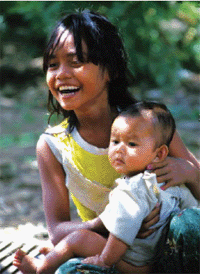Integrated Mekong development - the Basin Development Plan (BDP)

More than 60 million people live in the lower part of the Mekong Basin. Close to one third of the Basin population lives on less than one dollar per day and many in the Basin depend wholly or partially on the Basin's natural resources for their livelihood.
It is the job of the Mekong River Commission, which has four Member Countries; Cambodia, Lao PDR, Thailand and Viet Nam; to help the governments of the Basin sustainably manage Mekong water and related resources and help use these resources as a means for lifting the population out of poverty.
The Basin Development Plan (BDP) was devised to provide support to achieving this goal across the region in a consistent and synchronised manner and in a way that takes account of each Member Country's individual characteristics.
The BDP uses an "Integrated Water Resource Management (IWRM) approach" that facilitates a basin-wide planning process and partnerships with the basin's stakeholders, in order to reflect community interests. A central feature of MRC's approach is the consultative process that allows riparian countries to have an input in a range of possible development scenarios including hydropower schemes. The second phase of the programme (2007-2010) which began actual implementation in 2008, is designed to prepare a rolling IWRM-based Basin Development Plan that supports sustainable development in the Mekong Basin. The BDP is implemented by all Member Countries and complies with sound environmental and socio-economic principles. It consists of four components:
- Programme Management and Communication;
- Rolling IWRM-based Basin Development Plan;
- Knowledge Base and Assessment Tools; and
- IWRM-based Planning Capacity
In the first year of implementation, teething problems were experienced in the form of difficulties and delays by almost all national BDP units. These resulted in delays in the mobilising of research institutions/national expert teams to start updating sub-area reports. There were also staffing delays and the programme initially had difficulties in finding suitable trainers. However, these initial problems have been overcome and the BDP has accelerated its progress. Regular coordination meetings have helped to ensure close monitoring of activities at both regional and national levels and facilitating discussion amongst BDP teams for solutions.
Programme Management and Communication
The first Stakeholder Consultation for BDP was held in early
2008, which coincided with the release of the Inception Report.
The first donor review was conducted in May 2008 with members
from DANIDA, SIDA and AusAID on the panel. Though "understandable
delays" were noted, the review concluded that the programme
was on a "solid footing." To increase stakeholder
participation in the IWRM process at all levels, the MRC Regional
Meeting for Stakeholder Engagement was held in Vientiane, Lao
PDR, in November 2008. A draft Stakeholder Participation and
Communication Plan (SPCP) for BDP to guide the engagement of
and communication with stakeholders about the various activities
of the BDP has been written following national consultations.

Rolling IWRM-based Basin Development
Plan
A common understanding was established amongst Member Countries
and other stakeholders on how the BDP planning process would
continue. The countries agreed to bind by the principle of ensuring
the integration of basin concerns into national planning and
decision-making on Mekong water and related resources.
A Regional Technical Working Group with representatives from national planning agencies and water-related line agencies was established to support BDP's scenario and strategy work. The 28th Joint Committee meeting endorsed in principle, the defined development scenarios and the assessment criteria. On 25-27 September 2008, a preliminary hydrological assessment of selected basin-wide development scenarios was implemented to inform the Regional Multi-Stakeholder Consultation on Hydropower, and to support the scoping of the trans-boundary economic, social and environmental assessment. A detailed outline of the IWRM-based Basin Development Strategy was prepared and widely discussed.

Knowledge Base and Assessment Tools
In collaboration with the responsible MRC programmes and national
line agencies, the MRC began the process of identifying gaps
in sector knowledge. The emerging results were used to implement
preliminary scenario assessments. Guidelines for BDP's sub-area
activities were prepared but the start-up of the actual sub-area
activities faced considerable delays due to challenges in mobilising
capable implementation teams and preparing quality proposals.
IWRM-based Planning Capacity
Measures to improve the ability of stakeholders to participate
in the planning process began in 2008, with the participation
of line agencies, national planning agencies and Member Countries
in the BDP planning cycle. Experts from four Member Countries'
line agencies, working together as a team with an international
expert on hydropower and irrigation, participated in a round
table working group that looked at various development related
scenarios and an IWRM-based basin development strategy.
A study tour to the Columbia River Basin in the USA took place. Senior MRC officials and participants from the Member Countries were able to see for themselves the positive and negative impacts of high levels of basin development.
Expected outcomes for 2009
In 2009, the BDP programme, in collaboration with the Member
Countries and other MRC Programmes, will complete sector reviews
and sub-area profiles, train national trainers to deliver IWRM
planning courses in the riparian languages and produce the main
elements of the IWRMbased Basin Development Plan, in particular:
- Completion of the assessment of the defined basinwide development scenarios;
- Preparation of the final draft IWRM-based Basin Development Strategy, and the associated stakeholder engagement activities at the sub-area, national and basin levels; and
- Development of a Master Project Database and a preliminary Project Portfolio, including a process for the promotion and facilitation of sustainable projects and trans-boundary governance of controversial projects.
Choose a newsletter: